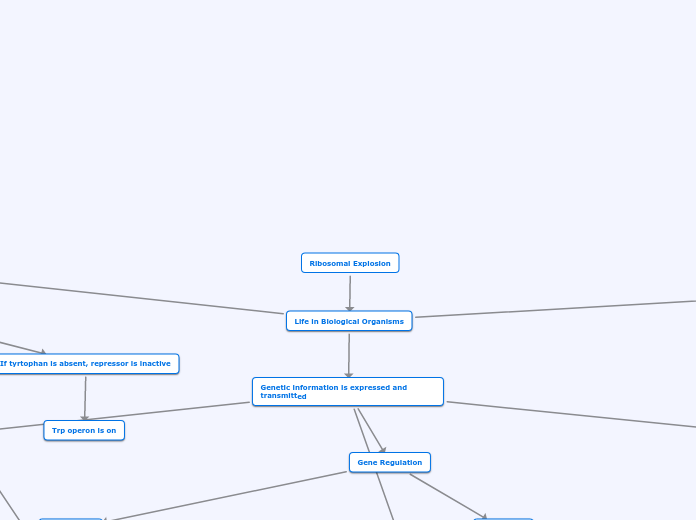作者:Berkin Kutluk 9 年以前
299
Ribosomal Explosion
Biological organisms rely on a series of intricate processes to sustain life, including cellular respiration and photosynthesis, which transform energy essential for living systems.

作者:Berkin Kutluk 9 年以前
299

更多类似内容
Interphase (G1 + S + G2)
Meiosis I
Prophase I
Metaphase I
Anaphase I
Telophase I + cytokinesis
Meiosis II
Very similar to Mitosis
Prophase II + Metaphase II + Anaphase II + Telophase II + cytokinesis
Sex gametes are produced. 4 haploid cells (n) with each one copy of chromosomes produced. Go on to form the diploid embryo (2n).
SSB Proteins and topoisomerase stabilizes the single strands and relieves tension in ssDNA
Leading Strand Synthesis
Synthesized in complementary strands continuously in a 5' to 3' direction. Only one RNA primer is needed
Lagging Strand Synthesis
Synthesized in Okazaki Fragments in 3' to 5' direction by addition of several RNA primers
RNA primers replaced and removed with DNA nucleotides
Fragments of DNA annealed and stick together by phosphodiester bonds
Mitosis and Cell Division (The Cell Cycle)
Interphase (G1 + S + G2) (DNA replication occurs at the synthesis/S Phase)
Prophase
Prometaphase
Metaphase
Anaphase
Telophase
Cytokinesis, cell divides into two by cleavage of cytoplasm. DNA replication ensures identical DNA distribution into two daughter cells.
Eukaryotes
Chromatin Modification and DNA packaging
Chromatin is coiled by histones to form nucleosomes, and supercoiled into tight helical fibers, and then wrapped into looped domains on protein scaffold.
Metaphase Chromosomes form (1400 nm in length)
Acetylation of protruding histone tails.
Promotes loose chromatin structure, and therefore available for transcription and gene expression. Genes turned on.
Combinatorial Gene regulation by specific transcription factors. At the transcription initiation stage.
Distal control elements and enhancers
Specific transcription factors
Bind to enhancers, and increase expression higher than basal level
DNA bending protein, brings closer to RNA polymerase, and mediator proteins, along with general transcription factors form active transcription complex
Cell Signaling
Hydrophobic Signaling
Signal molecule enters cytoplasm, and binds to receptor in cytoplasm
Receptor-Signal complex enters nucleus as a specific transcription factor and binds to DNA, and bind to promoter.
Hydrophilic Signaling
G-protein Receptor Pathway
G-protein binds to signal molecule. GTP binds to G-protein, and GDP knocked off. G-protein is active.
Binds to adenylyl cyclase
cAMP produced from ATP as a secondary messenger
Phosphorylation Cascade, and signal transduction pathway begins with activation of Protein Kinase A.
Specific and activator transcription factors produced.
Phosphodiesterase turns of cAMP signaling by converting cAMP to AMP.
Tyrosine Kinase Receptor Pathway
Signal molecule binds to receptor
Auto-phosphorylation of tyrosine tails activates tyrosine kinase receptor
Activates protein kinases
Phosphorylation Cascade
Specific Transcription Factors formed (activators for binding to enhancers in nucleus).
Cell response
Prokaryotes
Operons
Trp Operon
If tyrtophan is absent, repressor is inactive
Trp operon is on
If tyrtophan is present, acts as a corepressor, and can inhibit trp operon
Trp operon is off
Lac Operon
If lactose is absent, repressor is active.
If lactose present, it is an inducer, and inhibits lac repressor protein from binding to operator.
If glucose is absent, cAMP levels are high, CAP is active
Lac operon is on
If glucose is present, cAMP levels are low, CAP is inactive
Lac operon is off
Transcription
Translation
Protein Trafficking
Free Ribosomes synthesize polypeptides (with no Signal Peptide Sequence)
Nucleus and Peroxisomes
Chloroplast
Mitochondria
Endomembrane System Proteins
Post-Translational modification + glycosylation and lipidification of proteins in rough ER
Golgi apparatus
Plasma Membrane Proteins
Lysosomes